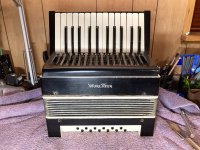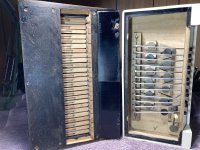cass
Member
greetings all, I have been given a small 25/12 Wurlitzer accordion. Stamped Made in America, serial 19003. Have done a little research and Wurlitzer doesn't appear to be anyone's favorite accordion. It appears to be complete, mostly intact, bellows seem tight. Has suffered some heavy-handed repair but I don't think any of it is fatal or impossible to reverse. I have some specific questions about it and am hoping to find someone who has one like this, another model of Wurlitzer or is knowledgeable about them. From the few notes I played, it seems to sound alright, it is small and very light. thanks in advance.



